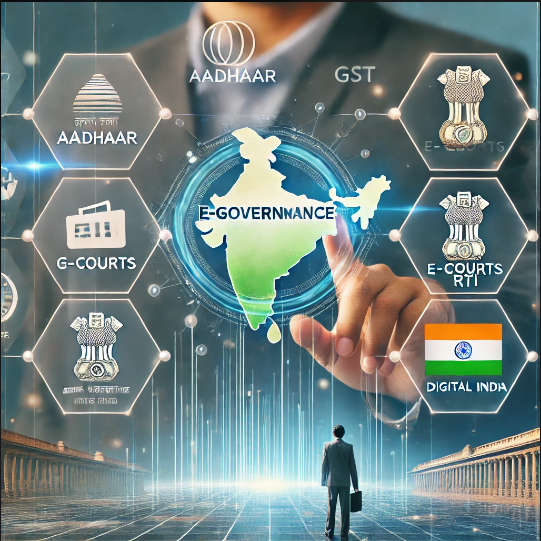Introduction
E-Governance, or electronic governance, refers to the use of information and communication technology (ICT) for the delivery of government services, exchange of information, and integration of various government departments. In India, e-Governance has emerged as a significant tool in ensuring transparency, efficiency, and accountability in governance. With the advent of Digital India and other initiatives, the country has witnessed remarkable progress in digital governance, empowering citizens and reducing bureaucratic red tape. This essay explores the evolution, impact, challenges, and future of e-Governance in India, emphasizing its role in promoting transparency.
Evolution of E-Governance in India
The journey of e-Governance in India began in the late 1980s with the launch of computerization initiatives in government offices. Some key milestones in this journey include:
- 1987 – National Informatics Centre (NIC) was established to promote e-Governance in government offices.
- 1990s – The government introduced computerization projects in various departments, including railways and income tax.
- 2000 – The National e-Governance Plan (NeGP) was launched to provide a structured approach to digital governance.
- 2015 – The Digital India campaign was introduced, aiming to transform India into a digitally empowered society and knowledge economy.
Objectives of E-Governance in India
The primary objectives of e-Governance in India are:
- Enhancing transparency and reducing corruption.
- Providing easy access to government services.
- Increasing efficiency and reducing delays in administration.
- Strengthening accountability in government operations.
- Bridging the digital divide and ensuring inclusivity.
Key E-Governance Initiatives in India
The Government of India has launched several e-Governance initiatives that have played a crucial role in promoting transparency. Some of the most significant initiatives include:
1. Digital India Programme
Launched in 2015, Digital India aims to transform India into a digitally empowered nation by ensuring access to digital infrastructure, e-services, and digital literacy. The programme focuses on providing seamless government services through technology.
2. Aadhaar (Unique Identification Number)
Aadhaar is the world’s largest biometric identification system, providing each citizen with a unique 12-digit number. It enables direct benefit transfer (DBT), reducing leakages and ensuring subsidies reach the intended beneficiaries.
3. Goods and Services Tax Network (GSTN)
GSTN is a digital platform that facilitates tax filing and compliance under the Goods and Services Tax (GST) regime. By digitizing tax records, it has reduced tax evasion and increased transparency in financial transactions.
4. e-Courts
The e-Courts project aims to provide online access to case records, enabling faster justice delivery. It enhances transparency by allowing litigants to track case proceedings digitally.
5. e-Tendering and e-Procurement
To curb corruption in public procurement, the government has introduced e-Tendering and e-Procurement systems, which ensure transparency in awarding contracts and government purchases.
6. UMANG (Unified Mobile Application for New-Age Governance)
UMANG integrates various government services on a single mobile platform, allowing citizens to access services related to Aadhaar, PAN, and pensions, among others.
7. RTI Online (Right to Information Act, 2005)
The RTI Online portal allows citizens to file and track Right to Information (RTI) applications digitally, promoting accountability and reducing delays in obtaining information.
Impact of E-Governance on Transparency
E-Governance has significantly contributed to transparency in India’s administrative system. The following are some of its key impacts:
1. Reduction in Corruption
By digitizing services, e-Governance has minimized human intervention, reducing opportunities for bribery and corruption. For instance, the Direct Benefit Transfer (DBT) system ensures that subsidies reach beneficiaries directly, eliminating middlemen.
2. Increased Accessibility and Public Participation
E-Governance platforms provide real-time access to information, empowering citizens to engage with the government effectively. Platforms like MyGov encourage citizen participation in policy-making.
3. Improved Service Delivery
Digital platforms ensure faster processing of government services, reducing bureaucratic delays. Services such as Passport Seva Kendra, online income tax filing, and digital land records have made governance more efficient.
4. Transparency in Financial Transactions
Digital payment systems such as BHIM, UPI, and PFMS (Public Financial Management System) have made government financial transactions more transparent, reducing pilferage and leakages.
5. Strengthened Legal and Judicial Transparency
E-Courts and digital case management systems ensure that legal proceedings are easily accessible, reducing case backlogs and enabling faster justice.
Challenges in Implementing E-Governance in India
Despite its benefits, e-Governance faces several challenges in India:
1. Digital Divide
A significant portion of the population, especially in rural areas, lacks access to digital infrastructure and literacy, limiting the reach of e-Governance.
2. Cybersecurity Threats
The increasing reliance on digital platforms exposes government databases to cybersecurity risks, including data breaches and hacking attempts.
3. Resistance to Change
Government employees and citizens accustomed to traditional governance methods often resist adopting new digital processes.
4. Lack of Internet Connectivity
Many remote regions still lack proper internet connectivity, making it difficult to access digital services.
5. Data Privacy Concerns
The collection and storage of personal data, especially through Aadhaar, raise concerns regarding privacy and data security.
Measures to Strengthen E-Governance
To address these challenges, the government must take the following measures:
- Bridging the Digital Divide: Expanding internet penetration and promoting digital literacy in rural areas.
- Enhancing Cybersecurity: Strengthening cybersecurity frameworks and implementing robust data protection laws.
- Capacity Building: Training government officials and citizens to effectively use digital governance platforms.
- Policy Reforms: Introducing stringent policies to ensure transparency, accountability, and data protection in e-Governance initiatives.
Future of E-Governance in India
The future of e-Governance in India is promising, with emerging technologies playing a crucial role in enhancing transparency and efficiency. Some future trends include:
1. Artificial Intelligence (AI) and Big Data
AI and Big Data will help analyze vast amounts of government data, improving decision-making and identifying corruption patterns.
2. Blockchain Technology
Blockchain can ensure secure and tamper-proof government records, enhancing transparency in land registration, supply chains, and financial transactions.
3. Smart Governance
The integration of smart technologies with governance will enable real-time monitoring of government projects and better resource allocation.
4. Internet of Things (IoT)
IoT-based governance can help in smart city initiatives, traffic management, and efficient public service delivery.
Conclusion
E-Governance has emerged as a powerful tool for promoting transparency, efficiency, and accountability in India. Initiatives such as Digital India, Aadhaar, and GSTN have transformed the way government services are delivered, minimizing corruption and improving public participation. However, challenges such as the digital divide, cybersecurity threats, and resistance to change need to be addressed through policy interventions and technological advancements. As India progresses towards a digital future, e-Governance will play a crucial role in ensuring inclusive and transparent governance, ultimately leading to a more accountable and citizen-centric administration.




